| C H A P T E R 1 |
|
Netra CP2300 cPSB Transition Card Overview and Installation |
The Netra CP2300 cPSB transition card (Sun part no. XCP2300-TRN, 375-3134-xx) is designed to be used with the Netra CP2300 cPSB board and is fully compliant with the CompactPCI Core Specification, Release Note for PICMG 2.0 Revision 3.0 (October 1999, PCI Industrial Computers Manufacturers Group).
The Netra CP2300 transition card is a fully compatible, carrier-grade cPSB I/O rear card for the Netra CP2300 board. However, Netra CP2300 transition card is not compatible with other CompactPCI or cPSB boards.
It is the responsibility of the system designer to integrate peripheral devices with the connectors on the backplane in a cPSB chassis configuration. A designer can either connect directly to the backplane signals or use a Netra CP2300 transition card. This document provides information only for the integration of the Netra CP2300 transition card in a supported cPSB chassis.
This chapter contains the following sections:
The Netra CP2300 transition card requires a chassis with a backplane that accommodates front and rear board installations. The primary purpose of this board is to provide the connection to Netra CP2300 board I/O devices. FIGURE 1-1 shows how the Netra CP2300 transition card and the Netra CP2300 board are connected through the backplane.
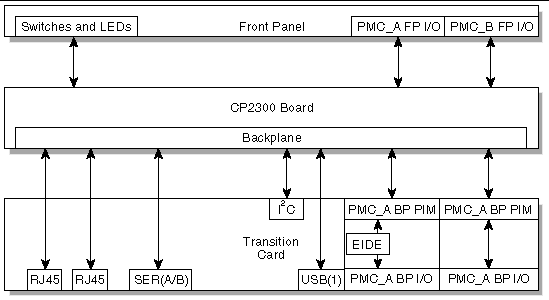
The 6U form factor, single-slot transition card supplies rear I/O connection to support additional peripherals with simplified system cabling for use with the compatible cPSB node boards. The rear I/O access also allows the Netra CP2300 boards to be replaced without disconnecting cables. Industry-standard connectors and pin assignments ensure ease of use and flexible design. The Netra CP2300 transition card permits the creation of high-density systems by allowing easy access to I/O.
The Netra CP2300 transition card provides additional I/O features through the CompactPCI rJ3 (labeled as J1 on the transition card) and the rJ5 (J2) connector interfaces to the Netra CP2300 board. Many I/O functions are provided on the transition card's own faceplate (FIGURE 1-2), as well as from headers mounted on the card (FIGURE 1-3).
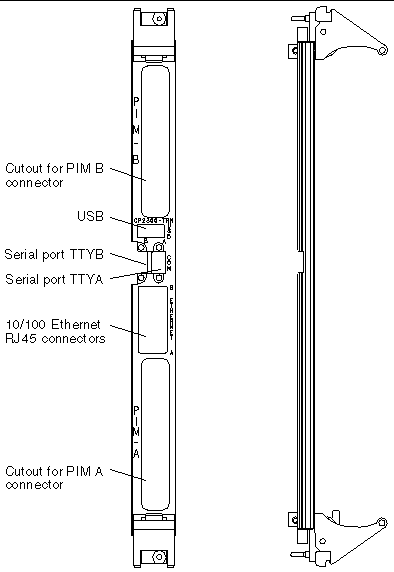
|
Note - Use shielded cables for the serial, USB, and Ethernet ports on the transition card. |
The Netra CP2300 transition card contains the following on-board components:
FIGURE 1-3 shows the location of these on-board components and other connectors.
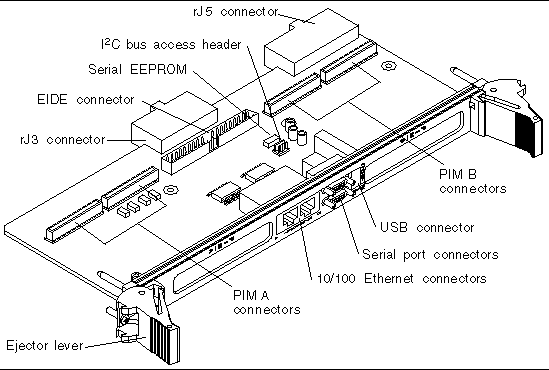
The Netra CP2300 transition card supports the Netra CP2300 board, and therefore, supports the software supported by that board. Refer to the Netra CP2300 cPSB Board Release Notes (817-1741-xx) and the Netra CP2300 cPSB Board Installation and Technical Reference Manual (816-7186-xx) for the software support information.
The Netra CP2300 cPSB transition card part number, serial number, and revision can be found on labels located on the card. For proper identification of the transition card, please find the Sun Microsystems barcode labels on the board. The barcode labels provide the following information:

The Netra CP2300 transition card supports two PMC I/O modules (PIMs). PIMs enable rear I/O access from the cPSB bus chassis. Custom PIMs can also provide additional I/O interfaces that do not fit on the transition card faceplate. (For more information on PIM slot mechanics, electrical and logical information, see VITA 36 - PMC I/O Module Standard available at http://www.vita.com and the IEEE P1386 Standard).
The PIM modules are available in two sizes (single-sized and double-sized). The Netra CP2300 transition card supports only single-sized PIMs, which measure
74 mm (2.92 inches) wide and 69 mm (2.72 inches) deep.
FIGURE 1-5 and FIGURE 1-6 show typical views of PIM cards when they are used with the Netra CP2300 transition card.
The CompactPCI connector I/O on the Netra CP2300 cPSB board provides matching I/O interfaces on the enclosure backpanel through the PIM cards installed on the Netra CP2300 transition card. The PMC A I/O signals are routed through the transition card's CompactPCI rJ3 connector (labeled J1 on the transition card). The PMC B I/O signals are routed through the transition card's CompactPCI rJ5 connector (J2). See FIGURE A-5 for the location of these connectors.
|
Note - Before installing a PIM card on the transition card, make sure that you set the DIP switches on the Netra CP2300 board correctly. See PIM Connectors and the Netra CP2300 cPSB Board Installation and Technical Reference Manual (817-1741-xx) for more information. |
An independent hardware vendor (IHV) supplied PMC card ship kit might include a PIM card hardware package. After installing the PIM card on the Netra CP2300 transition card, the PIM card provides rear I/O interfaces to the PMC card installed on the front Netra CP2300 cPSB board.

|
Caution - A PIM card must be used with its matching PMC card; any other card combination could lead to damaging the PIM and PMC card combination. |
|
Note - Mount the PIM cards on the Netra CP2300 transition card before inserting the Netra CP2300 transition card in the cPSB system. |
Refer to the PMC and PIM card documentation for complete hardware and software installation instructions.
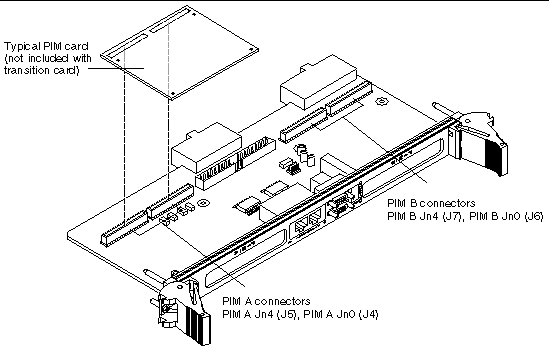

|
Note - The PIM cards shown in FIGURE 1-5 and FIGURE 1-6 are examples and are not included with the Netra CP2300 transition card shipment. |
The Netra CP2300 transition card can be installed into a cPSB chassis with a backplane made for front and rear board installation (FIGURE 1-7). It must be installed in the slot directly behind the Netra CP2300 board for proper operation. These back-to-back slots have common pins to enable passing of signals.
|
Note - Before installing the transition card, the card's part number must be verified to ensure that the correct transition card is being installed into the cPSB system. For information on identifying the transition card, see Determining Part Number, Serial Number, and Revision Number. |
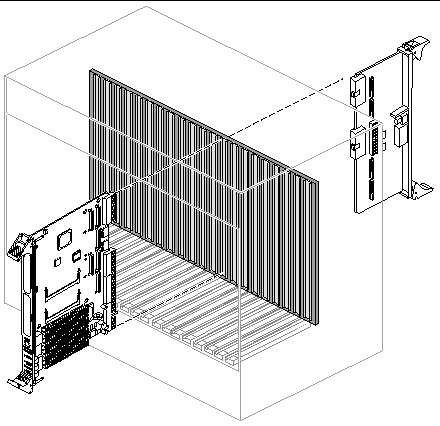
1. Install the PIM cards on the Netra CP2300 transition card before installing the Netra CP2300 transition card into the cPSB chassis.
Refer to the PMC and PIM card documentation for complete hardware and software installation instructions.
2. Ensure that power is disconnected from the cPSB chassis.
When the cPSB system is off, the Netra CP2300 transition card can be inserted either before or after installing the mating Netra CP2300 board.
|
Note - The Netra CP2300 transition card and the corresponding Netra board can be installed while the chassis is powered--however only start with a powered chassis if you must do so. |

|
Caution - Ensure that no Netra CP2300 cPSB board is installed in front of the rear backplane slot. This precaution is very important if you are installing into a powered backplane. |
The Netra CP2300 transition card is not hot-swappable. The transition card's entire power comes from the mating Netra CP2300 board (see also Power Requirements and Electrical Requirements).
3. Check the positioning of the Netra CP2300 transition card extraction levers.
Ensure that the Netra CP2300 transition card extraction levers are aligned perpendicular to the card flange.
4. Install the Netra CP2300 transition card into the chassis rear connector slot that lines up directly with the Netra CP2300 board (FIGURE 1-7).
a. Position the card with its CompactPCI rJ5 connector (labeled as J2 on the transition card) on top.
b. Engage the board edges with the chassis card guides and slide it into the chassis (FIGURE 1-8).
c. Using the ejector handles, gently maneuver the card into registration with the keying hardware and the shoulders surrounding the backplane pins, without the card socket contacts engaging these pins.
At this point, the card rear flange should project approximately 6 mm (1/4 inch) back from the "fully home" position.
d. Apply pressure to engage the pins and seat the board.
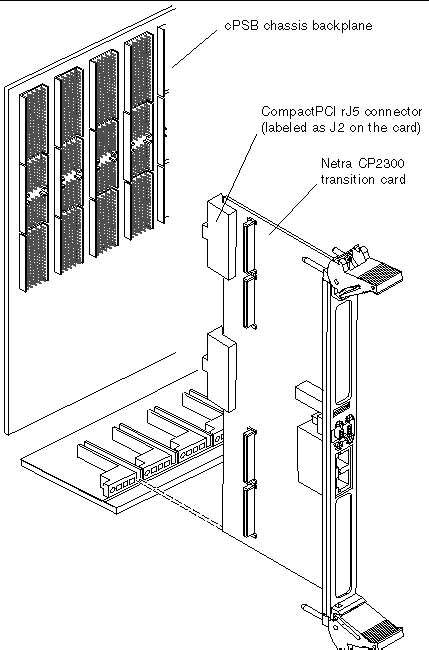
5. Install the Netra CP2300 board into the front of the chassis (FIGURE 1-7) and push the board towards the backplane to make sure it is seated properly and that the connectors make good contact with the Netra CP2300 transition card.
6. Install the supported peripheral devices at the transition card connector ports as required.
Use shielded cables for the ports on the transition card; the shield should be grounded at both ends. For further details on installation of the board, refer to the Netra CP2300 cPSB Board Installation and Technical Reference Manual (816-7186-xx).
Refer to your system manual for instructions on correctly powering on the system.
Copyright © 2003, Sun Microsystems, Inc. All rights reserved.